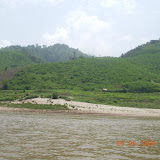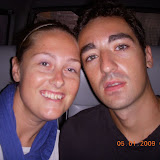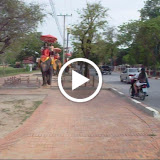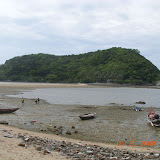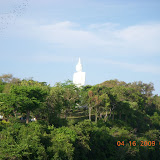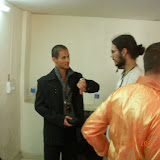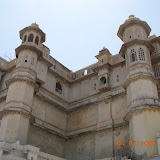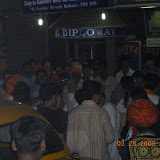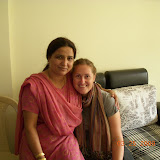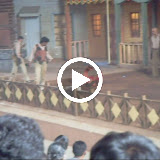
Tokyo was a very different experience than Kyoto. We arrived at the airport and took the train into the bustling city center. We got a little confused finding our hostel, but once we got checked in, we were right at home and ready to explore. We found a café near us that served great cheap eats, and the people there were very friendly. Some of the other customers smiled and welcomed us as we entered the shop. We had a great bowl of noodles and then headed across the street to visit the local temple.
The road to the temple was closed to traffic and was lined with souvenir shops. Shops selling snacks, chopsticks, golden waving cats, kimonos, kites, tea pots, etc. filled stalls in the classic Japanese style. It was a crowded boulevard with foreign and local tourists, and school groups dressed in uniforms wanting to interview tourists to practice their English. We completed an interview with a group of giggling school girls and helped them spell our answers in their notebooks. After a few hours of sightseeing we called it a night and turned in early. We had made a new friend, San from Thailand, and we all planned on heading out early the next morning for a full day on the town.

Our second day in Tokyo was a full one. We started out early with a trip to the Tsukiji Fish Market. The market is open every day from 6-9 am and is the largest fresh fish market in Japan. All the fresh catch from the day is sold to local restaurants and private buyers, and people line up early to get the freshest stuff. The market also is home to some great sushi restaurants, and people line up for sushi breakfast. We joined the crowd and ate a huge platter of sushi. I have never had sushi for breakfast, but I have to say that this was some of the best sushi I have ever eaten!
We left the fish market at 9 am, and found that none of the surrounding shops were open until 10. We went into a local coffee shop to kill time and plan our day. From there it was off to the Sony Building, where they show all the latest developments in personal electronics. Leon was in heaven! We spent hours looking at floor after floor of cameras, camcorder, computers, music players, and video games.

We left the Sony Building and ventured out into the surrounding area, known as the Ginza area. The Rodeo Drive of Tokyo, Ginza is full of high-end designer shops and expensive salons. While not exactly friendly to the backpacker budget, I had a good time window shopping and getting caught up on the latest fashion trends. (Payback for all those hours Leon made me feign interest in electronics.)

On our final day in Tokyo, we headed back to explore the local temple in more detail. This time we met a group of Japanese university students who offered to give us a tour to practice their English. The tour was great because it gave us a better understanding of the rituals that accompany a traditional temple visit. They explained to us to proper procedure for washing your hands and mouth before entering the temple, the traditional offering of 5 yen that you make upon entering the temple, and the correct method to offer prayers. They also showed us how to get our fortune from the booth outside the temple. They explained that you keep a good fortune with you, and if you get a bad fortune then you tie it to a post outside the temple to leave your bad luck behind you.
By mid-afternoon we decide that it was time to leave Tokyo behind us. We took the train back to the airport, and had one last meal before our marathon flight from Tokyo to Buenos Aires. We really enjoyed our two weeks in Japan, and wish that we could have seen more. Maybe one day we will return, with more time and a bigger budget!













